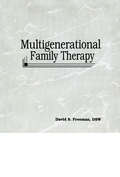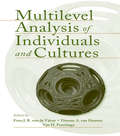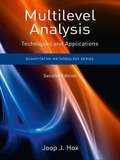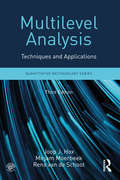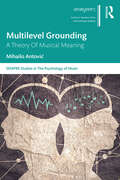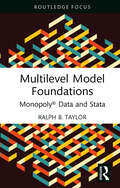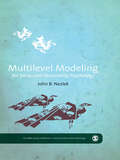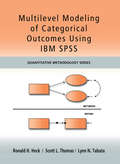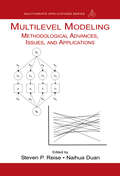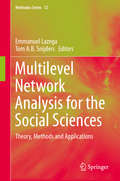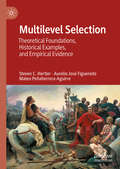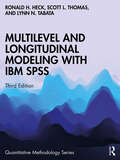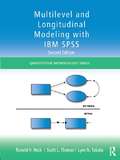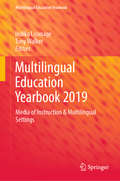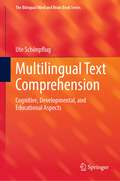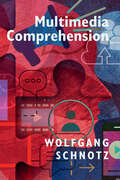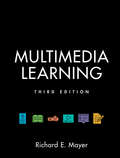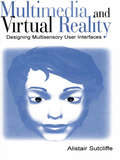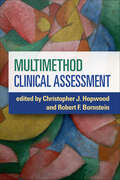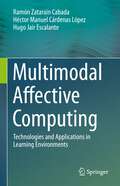- Table View
- List View
Multifunctional And Targeted Theranostic Nanomedicines: Formulation, Design And Applications
by N. K. Jain Keerti JainThis book discusses approaches based on multifunctional and targeted theranostic nanomedicines for improving diagnosis and drug delivery. It explores nanomedicines based on nanocarriers like liposomes, ethosomes, niosomes, polymeric nanoparticles, lipidic nanoparticles, metallic nanoparticles, micelles, dendrimers, quantum dots, carbon-based nanomaterials including carbon nanotubes, carbon dots, carbon quantum dots, graphene oxide, and fullerene. This book reviews designing, conjugation, optimization, formulation and development, and scale-up of multifunctional and targeted theranostic nanomedicines. It examines major challenges in developing nanomaterials that can be applied to nanomedicine with high biocompatibility and biodegradability for diagnostic and therapeutic purposes. Lastly, it addresses the most promising approaches at both commercialization and regulatory steps for bringing theranostic nanomedicine from research laboratories to clinics for patient use.
Multigenerational Family Therapy
by David S FreemanMultigenerational Family Therapy is a book about honoring and helping families. Rich with personal reflections and anecdotes from the author’s many years as a family therapist, this volume’s major strength lies in its precise definition of the process and content of the therapy itself. As the family is the major resource system available to an individual, this important book provides therapists with the keys for helping family members help each other and provides a framework for understanding how the family, as a multigenerational system, moves through various stages of the therapeutic process. By emphasizing the importance of family members utilizing the past as a positive force for change and featuring complete transcripts of family therapy sessions, this sensitive book clearly illustrates how therapists can use the positive forces of family for dealing with today’s uncertainties and dilemmas. The step-by-step approach details how family therapists can work with families in a positive, healing manner. Several chapters illustrate the transition from the beginning to middle phases of family therapy to the terminating phase and provide a framework for how therapy evolves over time. Other chapters discuss the special skills required to work with various family constellations, such as couples, parents with children, siblings, adult children with aged parents, and individuals as well as extended family members. Helpful advice on how to deal with special issues and dilemmas of family therapy such as secret-keeping, affairs, co-therapy, crises and emergencies is also included in this comprehensive book. Beginning and advanced family therapy practitioners, students of family theory and therapy, faculty of social work practice, clinical psychology, nursing, family life education, and counseling psychology will find many positive ideas for working with families in this detailed book.
Multilevel Analysis of Individuals and Cultures
by Ype H. Poortinga Fons J.R. van de Vijver Dianne A. Van HemertIn this book, top specialists address theoretical, methodological, and empirical multilevel models as they relate to the analysis of individual and cultural data. Divided into four parts, the book opens with the basic conceptual and theoretical issues in multilevel research, including the fallacies of such research. Part II describes the methodological aspects of multilevel research, including data-analytic and structural equation modeling techniques. Applications and models from various research areas including control, values, organizational behavior, social beliefs, well-being, personality, response styles, school performance, family, and acculturation, are explored in Part III. This section also deals with validity issues in aggregation models. The book concludes with an overview of the kinds of questions addressed in multilevel models and highlights the theoretical and methodological issues yet to be explored. This book is intended for researchers and advanced students in psychology, sociology, social work, marriage and family therapy, public health, anthropology, education, economics, political science, and cultural and ethnic studies who study the relationship between behavior and culture.
Multilevel Analysis: Techniques and Applications, Second Edition
by Joop J. Hox Rens van de Schoot Mirjam MoerbeekThis practical introduction helps readers apply multilevel techniques to their research. Noted as an accessible introduction, the book also includes advanced extensions, making it useful as both an introduction and as a reference to students, researchers, and methodologists. Basic models and examples are discussed in non-technical terms with an emphasis on understanding the methodological and statistical issues involved in using these models. The estimation and interpretation of multilevel models is demonstrated using realistic examples from various disciplines. For example, readers will find data sets on stress in hospitals, GPA scores, survey responses, street safety, epilepsy, divorce, and sociometric scores, to name a few. The data sets are available on the website in SPSS, HLM, MLwiN, LISREL and/or Mplus files. Readers are introduced to both the multilevel regression model and multilevel structural models. Highlights of the second edition include: Two new chapters--one on multilevel models for ordinal and count data (Ch. 7) and another on multilevel survival analysis (Ch. 8). Thoroughly updated chapters on multilevel structural equation modeling that reflect the enormous technical progress of the last few years. The addition of some simpler examples to help the novice, whilst the more complex examples that combine more than one problem have been retained. A new section on multivariate meta-analysis (Ch. 11). Expanded discussions of covariance structures across time and analyzing longitudinal data where no trend is expected. Expanded chapter on the logistic model for dichotomous data and proportions with new estimation methods. An updated website at http://www.joophox.net/ with data sets for all the text examples and up-to-date screen shots and PowerPoint slides for instructors. Ideal for introductory courses on multilevel modeling and/or ones that introduce this topic in some detail taught in a variety of disciplines including: psychology, education, sociology, the health sciences, and business. The advanced extensions also make this a favorite resource for researchers and methodologists in these disciplines. A basic understanding of ANOVA and multiple regression is assumed. The section on multilevel structural equation models assumes a basic understanding of SEM.
Multilevel Analysis: Techniques and Applications, Third Edition (Quantitative Methodology Series )
by Joop J. Hox Rens van de Schoot Mirjam MoerbeekApplauded for its clarity, this accessible introduction helps readers apply multilevel techniques to their research. The book also includes advanced extensions, making it useful as both an introduction for students and as a reference for researchers. Basic models and examples are discussed in nontechnical terms with an emphasis on understanding the methodological and statistical issues involved in using these models. The estimation and interpretation of multilevel models is demonstrated using realistic examples from various disciplines including psychology, education, public health, and sociology. Readers are introduced to a general framework on multilevel modeling which covers both observed and latent variables in the same model, while most other books focus on observed variables. In addition, Bayesian estimation is introduced and applied using accessible software.
Multilevel Dynamics in Developmental Psychopathology: Pathways to the Future: The Minnesota Symposia on Child Psychology, Volume 34 (Minnesota Symposia On Child Psychology Ser. #Vol. 34)
by Ann S. MastenThis latest volume in The Minnesota Symposia on Child Psychology Series highlights recent research across multiple levels of analysis to understand processes that shape development toward and away from behavioral problems and disorders over the life course, including the pathways to mental health. The book examines how dramatic advances in technolo
Multilevel Grounding: A Theory Of Musical Meaning (SEMPRE Studies in The Psychology of Music)
by Mihailo AntovićMultilevel Grounding develops a new approach to musical meaning—Multilevel-Grounded Semantics, addressing the well- known paradox that music seems full of meaning yet there is little consensus among listeners on what exactly it is that this meaning communicates. Offering a balance between formalist and referentialist approaches, Antovi ć ’s theory proposes that musical signifi cation emerges from constant cross- space mappings between the musical structure and the listener’s experience. The process is crucially constrained by several hierarchical and partly recursive levels of grounding: perceptual, schematically embodied, affective, conceptual, culturally elaborated, and individual. These levels are responsible for a range of phenomena that increase in complexity, from involuntary bodily responses to the manipulation of musical expectancies over cross- modal inferences relating the musical parameters to spatial domains to full- fl edged experiential narratives accompanying the music, as in opera or fi lm scoring. The book combines cutting edge insights from the fi elds of philosophy of mind, cognitive science, semiotics, linguistics, and music cognition, using a broad range of examples from traditional, classical, and popular world musics, into a theoretical system that shows how the focus on the grounding problem may help researchers convincingly resolve the apparent ungraspability of musical semantics.
Multilevel Model Foundations: Monopoly® Data and Stata
by Ralph B. TaylorThis book introduces the foundations of multilevel models, using Monopoly® rent data, from the classic board game, and the statistical program Stata®. Widespread experience with the game means many readers have a head start on understanding these models. The small-data set, 132 rent values for 22 properties clustered by the four sides of the playing board, combines with extensive graphical displays of data and results so all readers can see core multilevel ideas in action at a granular level. Two chapters on standard statistical models, one-way analysis of variance and multiple regression, help readers see how multilevel models rely on but also extend these monolevel ideas. Chapters present three basic multilevel models for cross-sectional analyses – analysis of variance, analysis of covariance, and random coefficients regression – and one basic developmental model for longitudinal analyses. Troubleshooting guidance, combined with close examination of data patterns, and careful inspection of model parameters, all help readers better grasp what model results mean, when model results should or should not be trusted, and how model results link back to core theoretical questions. Consequently, readers will develop a sense of best practices for building and diagnosing their own multilevel models. Those who complete the volume can readily apply what they have learned to more complex datasets and models and adapt available online Stata do files to those projects. Any social scientist working with data clustered in time, in space, or in both, and seeking to learn more about how to use, interpret, or teach these models, will find the book useful.
Multilevel Modeling for Social and Personality Psychology (The SAGE Library of Methods in Social and Personality Psychology)
by John B. NezlekThe volume begins with a rationale for multilevel modeling (MLM). Different aspects of MLM such as centering and modeling error terms are discussed, and examining hypotheses within the multilevel framework is considered in detail. Step by step instructions for conducting multilevel analyses using the program HLM are presented, and these instructions are linked to data sets and program files on a website. The SAGE Library in Social and Personality Psychology Methods provides students and researchers with an understanding of the methods and techniques essential to conducting cutting-edge research. Each volume within the Library explains a specific topic and has been written by an active scholar (or scholars) with expertise in that particular methodological domain. Assuming no prior knowledge of the topic, the volumes are clear and accessible for all readers. In each volume, a topic is introduced, applications are discussed, and readers are led step by step through worked examples. In addition, advice about how to interpret and prepare results for publication are presented.
Multilevel Modeling of Categorical Outcomes Using IBM SPSS: Multilevel Modeling Of Categorical Outcomes Using Ibm Spss (Quantitative Methodology Series)
by Scott Thomas Ronald H Heck Lynn TabataThis is the first workbook that introduces the multilevel approach to modeling with categorical outcomes using IBM SPSS Version 20. Readers learn how to develop, estimate, and interpret multilevel models with categorical outcomes. The authors walk readers through data management, diagnostic tools, model conceptualization, and model specification issues related to single-level and multilevel models with categorical outcomes. Screen shots clearly demonstrate techniques and navigation of the program. Modeling syntax is provided in the appendix. Examples of various types of categorical outcomes demonstrate how to set up each model and interpret the output. Extended examples illustrate the logic of model development, interpretation of output, the context of the research questions, and the steps around which the analyses are structured. Readers can replicate examples in each chapter by using the corresponding data and syntax files available at www.psypress.com/9781848729568. The book opens with a review of multilevel with categorical outcomes, followed by a chapter on IBM SPSS data management techniques to facilitate working with multilevel and longitudinal data sets. Chapters 3 and 4 detail the basics of the single-level and multilevel generalized linear model for various types of categorical outcomes. These chapters review underlying concepts to assist with trouble-shooting common programming and modeling problems. Next population-average and unit-specific longitudinal models for investigating individual or organizational developmental processes are developed. Chapter 6 focuses on single- and multilevel models using multinomial and ordinal data followed by a chapter on models for count data. The book concludes with additional trouble shooting techniques and tips for expanding on the modeling techniques introduced. Ideal as a supplement for graduate level courses and/or professional workshops on multilevel, longitudinal, latent variable modeling, multivariate statistics, and/or advanced quantitative techniques taught in psychology, business, education, health, and sociology, this practical workbook also appeals to researchers in these fields. An excellent follow up to the authors’ highly successful Multilevel and Longitudinal Modeling with IBM SPSS and Introduction to Multilevel Modeling Techniques, 2nd Edition, this book can also be used with any multilevel and/or longitudinal book or as a stand-alone text introducing multilevel modeling with categorical outcomes.
Multilevel Modeling: Methodological Advances, Issues, and Applications (Multivariate Applications Series)
by Steven P. Reise Naihua DuanThis book illustrates the current work of leading multilevel modeling (MLM) researchers from around the world. The book's goal is to critically examine the real problems that occur when trying to use MLMs in applied research, such as power, experimental design, and model violations. This presentation of cutting-edge work and statistical innovations in multilevel modeling includes topics such as growth modeling, repeated measures analysis, nonlinear modeling, outlier detection, and meta analysis. This volume will be beneficial for researchers with advanced statistical training and extensive experience in applying multilevel models, especially in the areas of education; clinical intervention; social, developmental and health psychology, and other behavioral sciences; or as a supplement for an introductory graduate-level course.
Multilevel Network Analysis for the Social Sciences
by Emmanuel Lazega Tom A.B. SnijdersThis volume provides new insights into the functioning of organizational, managerial and market societies. Multilevel analysis and social network analysis are described and the authors show how they can be combined in developing the theory, methods and empirical applications of the social sciences. This book maps out the development of multilevel reasoning and shows how it can explain behavior, through two different ways of contextualizing it. First, by identifying levels of influence on behavior and different aggregations of actors and behavior, and complex interactions between context and behavior. Second, by identifying different levels as truly different systems of agency: such levels of agency can be examined separately and jointly since the link between them is affiliation of members of one level to collective actors at the superior level. It is by combining these approaches that this work offers new insights. New case studies and datasets that explore new avenues of theorizing and new applications of methodology are presented. This book will be useful as a reference work for all social scientists, economists and historians who use network analyses and multilevel statistical analyses. Philosophers interested in the philosophy of science or epistemology will also find this book valuable.
Multilevel Selection: Theoretical Foundations, Historical Examples, and Empirical Evidence
by Steven C. Hertler Aurelio José Figueredo Mateo Peñaherrera-AguirreThis book embeds a novel evolutionary analysis of human group selection within a comprehensive overview of multilevel selection theory, a theory wherein evolution proceeds at the level of individual organisms and collectives, such as human families, tribes, states, and empires. Where previous works on the topic have variously supported multilevel selection with logic, theory, experimental data, or via review of the zoological literature; in this book the authors uniquely establish the validity of human group selection as a historical evolutionary process within a multilevel selection framework.Select portions of the historical record are examined from a multilevel selectionist perspective, such that clashing civilizations, decline and fall, law, custom, war, genocide, ostracism, banishment, and the like are viewed with the end of understanding their implications for internal cohesion, external defense, and population demography. In doing so, its authors advance the potential for further interdisciplinary study in fostering, for instance, the convergence of history and biology. This work will provide fresh insights not only for evolutionists but also for researchers working across the social sciences and humanities.
Multilevel and Longitudinal Modeling with IBM SPSS (Quantitative Methodology Series)
by Ronald H. Heck Scott L. Thomas Lynn N. TabataMultilevel and Longitudinal Modeling with IBM SPSS, Third Edition, demonstrates how to use the multilevel and longitudinal modeling techniques available in IBM SPSS Versions 25-27. Annotated screenshots with all relevant output provide readers with a step-by-step understanding of each technique as they are shown how to navigate the program. Throughout, diagnostic tools, data management issues, and related graphics are introduced. SPSS commands show the flow of the menu structure and how to facilitate model building, while annotated syntax is also available for those who prefer this approach. Extended examples illustrating the logic of model development and evaluation are included throughout the book, demonstrating the context and rationale of the research questions and the steps around which the analyses are structured. The book opens with the conceptual and methodological issues associated with multilevel and longitudinal modeling, followed by a discussion of SPSS data management techniques that facilitate working with multilevel, longitudinal, or cross-classified data sets. The next few chapters introduce the basics of multilevel modeling, developing a multilevel model, extensions of the basic two-level model (e.g., three-level models, models for binary and ordinal outcomes), and troubleshooting techniques for everyday-use programming and modeling problems along with potential solutions. Models for investigating individual and organizational change are next developed, followed by models with multivariate outcomes and, finally, models with cross-classified and multiple membership data structures. The book concludes with thoughts about ways to expand on the various multilevel and longitudinal modeling techniques introduced and issues (e.g., missing data, sample weights) to keep in mind in conducting multilevel analyses. Key features of the third edition: Thoroughly updated throughout to reflect IBM SPSS Versions 26-27. Introduction to fixed-effects regression for examining change over time where random-effects modeling may not be an optimal choice. Additional treatment of key topics specifically aligned with multilevel modeling (e.g., models with binary and ordinal outcomes). Expanded coverage of models with cross-classified and multiple membership data structures. Added discussion on model checking for improvement (e.g., examining residuals, locating outliers). Further discussion of alternatives for dealing with missing data and the use of sample weights within multilevel data structures. Supported by online data sets, the book's practical approach makes it an essential text for graduate-level courses on multilevel, longitudinal, latent variable modeling, multivariate statistics, or advanced quantitative techniques taught in departments of business, education, health, psychology, and sociology. The book will also prove appealing to researchers in these fields. The book is designed to provide an excellent supplement to Heck and Thomas's An Introduction to Multilevel Modeling Techniques, Fourth Edition; however, it can also be used with any multilevel or longitudinal modeling book or as a stand-alone text.
Multilevel and Longitudinal Modeling with IBM SPSS: Multilevel And Longitudinal Modeling With Ibm Spss (Quantitative Methodology Series)
by Ronald H. Heck Scott L. Thomas Lynn N. TabataThis book demonstrates how to use multilevel and longitudinal modeling techniques available in the IBM SPSS mixed-effects program (MIXED). Annotated screen shots provide readers with a step-by-step understanding of each technique and navigating the program. Readers learn how to set up, run, and interpret a variety of models. Diagnostic tools, data management issues, and related graphics are introduced throughout. Annotated syntax is also available for those who prefer this approach. Extended examples illustrate the logic of model development to show readers the rationale of the research questions and the steps around which the analyses are structured. The data used in the text and syntax examples are available at www.routledge.com/9780415817110. Highlights of the new edition include: Updated throughout to reflect IBM SPSS Version 21. Further coverage of growth trajectories, coding time-related variables, covariance structures, individual change and longitudinal experimental designs (Ch.5). Extended discussion of other types of research designs for examining change (e.g., regression discontinuity, quasi-experimental) over time (Ch.6). New examples specifying multiple latent constructs and parallel growth processes (Ch. 7). Discussion of alternatives for dealing with missing data and the use of sample weights within multilevel data structures (Ch.1). The book opens with the conceptual and methodological issues associated with multilevel and longitudinal modeling, followed by a discussion of SPSS data management techniques which facilitate working with multilevel, longitudinal, and cross-classified data sets. Chapters 3 and 4 introduce the basics of multilevel modeling: developing a multilevel model, interpreting output, and trouble-shooting common programming and modeling problems. Models for investigating individual and organizational change are presented in chapters 5 and 6, followed by models with multivariate outcomes in chapter 7. Chapter 8 provides an illustration of multilevel models with cross-classified data structures. The book concludes with ways to expand on the various multilevel and longitudinal modeling techniques and issues when conducting multilevel analyses. Ideal as a supplementary text for graduate courses on multilevel and longitudinal modeling, multivariate statistics, and research design taught in education, psychology, business, and sociology, this book’s practical approach also appeals to researchers in these fields. The book provides an excellent supplement to Heck & Thomas’s An Introduction to Multilevel Modeling Techniques, 2nd Edition; however, it can also be used with any multilevel and/or longitudinal modeling book or as a stand-alone text.
Multilingual Education Yearbook 2019: Media of Instruction & Multilingual Settings (Multilingual Education Yearbook)
by Indika Liyanage Tony WalkerThis book offers essential insights into the challenges and complexities surrounding the medium of instruction (MOI), its impact on all languages and stakeholders in multilingual contexts, educational processes, developments and outcomes. MOI has been a prominent topic in recent debates on the role of languages in education in multilingual contexts, partly because prioritizing one language over others as the medium of instruction has a profound impact on all languages and stakeholders in multilingual contexts. These include, to name but a few, (language) teachers, teacher educators, students, and policymakers, as well as industries and enterprises built around the needs and expectations of these stakeholders. This book presents high-quality empirical research on education in multilingual societies. It highlights research findings that, in addition to providing descriptions of language learning, development and use in language contact and multilingual contexts, will help shape future language education policy and practices in multilingual societies.
Multilingual Lexical Recognition in the Mental Lexicon of Third Language Users
by Weronika Szubko-SitarekThe monograph constitutes an attempt to demonstrate that trilinguals should be considered as learners and speakers in their own right as opposed to L2 learners with a view to enumerating consequences this would bring to third or additional language teaching. Its theoretical part offers an insight into the structure of the multilingual mental lexicon which is a product of the interplay of a whole array of cross-linguistic factors in the minds of multilingual speakers. The empirical part reports the findings of an empirical study which aimed to investigate connections which are formed between multiple languages in a multilingual mind. All the aspects, analyzed in the experiments are part of a broader question of how multilinguals make their lexical decisions and, more specifically, how they recognize words from different languages. The book closes with the discussion of the role of the obtained results for multilingual didactics as well as some possible areas for future research.
Multilingual Text Comprehension: Cognitive, Developmental, and Educational Aspects (The Bilingual Mind and Brain Book Series)
by Ute SchönpflugUntil today, research on monolingual text processing has offered a broad spectrum of results and theoretical explanations of how texts are processed. This book extends the current trend to cover only reading comprehension by considering extensively listening comprehension. Comprehensive presentations of research on children’s listening comprehension allow for a broader developmental perspective reaching preschool years. Although text comprehension is the essence of learning in educational settings, and children are confronted continuously with the challenge of getting information from texts, comprehensive publications on children’s text comprehension are scarce. The author posits that a comprehensive review of children’s comprehension processes has to analyze the development of fundamental cognitive processes involved in comprehension. Therefore, this book covers the impact of working and long-term memory, metamemory, inference making, and gist building on comprehension performance. The role of first and multilingual language proficiency and tasks on specific component processes of text comprehension are discussed. Research results concerning the function of multilingual proficiency and tasks in text comprehension are complemented by the author’s own published and unpublished research. Theoretical considerations lead to models attempting to cover aspects of multilingual text comprehension. The aim of the book is to present a state-of-the-art overview of the field to inform researchers and students of various disciplines and practitioners to improve their understanding of how to foster multilingual text comprehension.
Multilingualism
by Anat Stavans Charlotte HoffmannHow do children and adults become multilingual? How do they use their languages? What influence does being multilingual have on their identities? What is the social impact of multilingualism today and how do societies accommodate it? These are among the fascinating questions examined by this book. Exploring multilingualism in individuals and in society at large, Stavans and Hoffmann argue that it evolves not from one factor in particular, but from a vast range of environmental and personal influences and circumstances: from migration to globalisation, from the spread of English to a revived interest in minority languages, from social mobility to intermarriage. The book shows the important role of education in helping to promote or maintain pupils' multilingual language competence and multilingual literacy, and in helping to challenge traditional monolingual attitudes. A clear and incisive account of this growing phenomenon, it is essential reading for students, teachers and policy-makers alike.
Multimedia Comprehension
by Wolfgang SchnotzMultimedia messages use combinations of texts, pictures, maps, and graphs as tools for communication. This book provides a synthesis of theory and research about how people comprehend multimedia. It adopts the perspectives of cognitive psychology, semiotics, anthropology, linguistics, education, and art. Its central idea is that information displays can be categorized into two different but complementary forms of representations, which service different purposes in human cognition and communication. Specific interaction between these representations enhances comprehension, thinking, and problem solving, as illustrated by numerous examples. Multimedia Comprehension is written for a broad audience with no special prior knowledge. It is of interest to everyone trying to understand how people comprehend multimedia, from scholars and students in psychology, communication, and education, to web- and interface-designers and instructors.
Multimedia Learning (Cambridge Handbooks In Psychology Ser.)
by Richard MayerAdvances in computer graphic technologies have inspired new efforts to understand the potential of multimedia instruction as a means of promoting human learning. In Multimedia Learning, Third Edition, Richard E. Mayer takes an evidence-based approach to improving education using well-designed multimedia instruction. He reviews 15 principles of multimedia instructional design that are based on more than 200 experimental research studies and grounded in a cognitive theory of how people learn from words and graphics. The result is the latest instalment of what Mayer calls the Cognitive Theory of Multimedia Learning, a theory introduced in previous editions of Multimedia Learning and in The Cambridge Handbook of Multimedia Learning, Second Edition. This edition provides an up-to-date and systematic summary of research studies on multimedia learning, supplemented with complementary evidence from around the globe. It is well-suited to graduate and undergraduate courses in psychology, education, computer science, communication, instructional design, and game design.
Multimedia and Virtual Reality: Designing Multisensory User Interfaces
by Alistair SutcliffeThis book is primarily a summary of research done over 10 years in multimedia and virtual reality, which fits within a wider interest of exploiting psychological theory to improve the process of designing interactive systems. The subject matter lies firmly within the field of HCI, with some cross-referencing to software engineering. Extending Sutcliffe's views on the design process to more complex interfaces that have evolved in recent years, this book: *introduces the background to multisensory user interfaces and surveys the design issues and previous HCI research in these areas; *explains the basic psychology for design of multisensory user interfaces, including the Interactive Cognitive Subsystems cognitive model; *describes elaborations of Norman's models of action for multimedia and VR, relates these models to the ICS cognitive model, and explains how the models can be applied to predict the design features necessary for successful interaction; *provides a design process from requirements, user and domain analysis, to design of representation in media or virtual worlds and facilities for user interaction therein; *covers usability evaluation for multisensory interfaces by extending existing well-known HCI approaches of heuristic evaluation and observational usability testing; and *presents two special application areas for multisensory interfaces: educational applications and virtual prototyping for design refinement. To download images and figures free of charge that enhance and clarify materials discussed in chapters 1-7 go to http://www.co.umist.ac.uk/centreULhci/MMVRbook.htm
Multimethod Clinical Assessment
by Robert F. Bornstein Christopher J. HopwoodFrom leading authorities, this book presents evidence-based strategies for using multimethod assessment to enhance clinical practice. The volume is organized around key assessment targets in the areas of personality, psychopathology, and clinical management (for example, treatment planning and progress monitoring). Each chapter presents multiple methods that are particularly useful for assessing the issue at hand, provides a framework for using these methods together, and reviews the empirical data supporting their integration. Illustrative case examples clarify the approaches described and show how incorporating assessment into treatment can strengthen the therapeutic relationship.
Multimethod Clinical Assessment
by Robert F. Bornstein Christopher J. HopwoodFrom leading authorities, this book presents evidence-based strategies for using multimethod assessment to enhance clinical practice. The volume is organized around key assessment targets in the areas of personality, psychopathology, and clinical management (for example, treatment planning and progress monitoring). Each chapter presents multiple methods that are particularly useful for assessing the issue at hand, provides a framework for using these methods together, and reviews the empirical data supporting their integration. Illustrative case examples clarify the approaches described and show how incorporating assessment into treatment can strengthen the therapeutic relationship.
Multimodal Affective Computing: Technologies and Applications in Learning Environments
by Hugo Jair Escalante Ramón Zatarain Cabada Héctor Manuel LópezThis book explores AI methodologies for the implementation of affective states in intelligent learning environments. Divided into four parts, Multimodal Affective Computing: Technologies and Applications in Learning Environments begins with an overview of Affective Computing and Intelligent Learning Environments, from their fundamentals and essential theoretical support up to their fusion and some successful practical applications. The basic concepts of Affective Computing, Machine Learning, and Pattern Recognition in Affective Computing, and Affective Learning Environments are presented in a comprehensive and easy-to-read manner. In the second part, a review on the emerging field of Sentiment Analysis for Learning Environments is introduced, including a systematic descriptive tour through topics such as building resources for sentiment detection, methods for data representation, designing and testing the classification models, and model integration into a learning system. The methodologies corresponding to Multimodal Recognition of Learning-Oriented Emotions are presented in the third part of the book, where topics such as building resources for emotion detection, methods for data representation, multimodal recognition systems, and multimodal emotion recognition in learning environments are presented. The fourth and last part of the book is devoted to a wide application field of the combination of methodologies, such as Automatic Personality Recognition, dealing with issues such as building resources for personality recognition, methods for data representation, personality recognition models, and multimodal personality recognition for affective computing. This book can be very useful not only for beginners who are interested in affective computing and intelligent learning environments, but also for advanced and experts in the practice and developments of the field. It complies an end-to-end treatment on these subjects, especially with educational applications, making it easy for researchers and students to get on track with fundamentals, established methodologies, conventional evaluation protocols, and the latest progress on these subjects.

